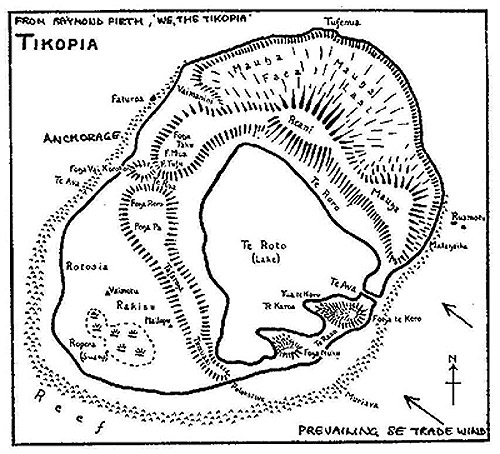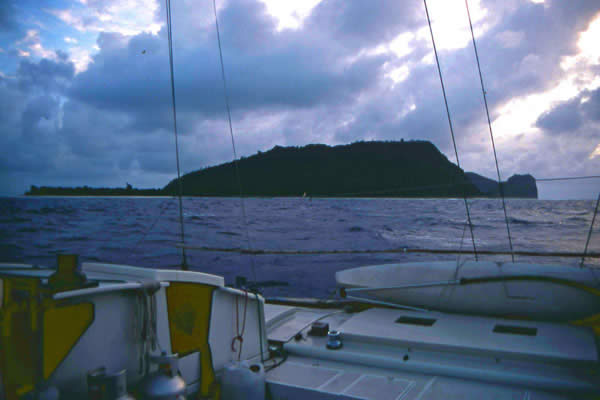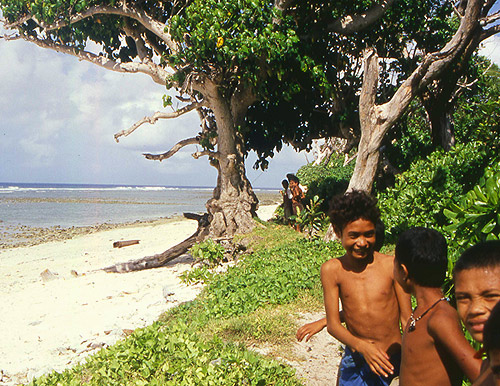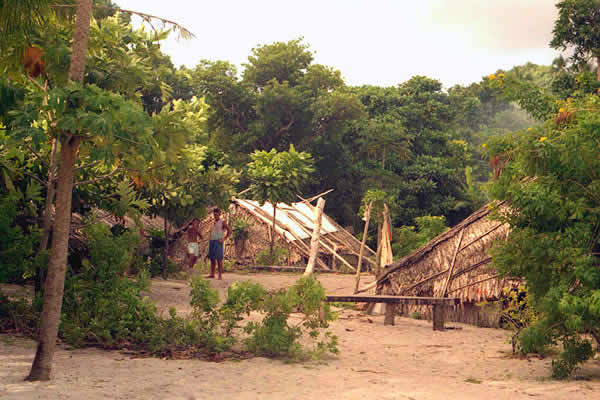Inspiration
An idea conceived by Hanneke Boon of James Wharram Designs, 1st February 2005
This is a proposal for a project to give the people of the tiny Pacific island of Tikopia back independent sea transport, in the form of a seagoing sailing double canoe.
At present the only transport to and from the island of Tikopia is by an old Solomon Islands Government controlled ship (picture below), which calls at the island about every 3 months. Islanders that leave the island on the ship have to wait for its return before being able to go home. Tikopians living on other islands have to take 6 months leave to visit their home island and family. The ship is also the only means of bringing in outside supplies. Occasionally passing yachts visit the island, via which messages and letters can been sent.

The only craft on the island are small outrigger canoes, used for fishing and too small for longer sea voyages. There are no other watercraft, no outboard motors and no fuel. There is no airstrip and it is too far for a helicopter to reach.
A new seagoing canoe will give back Tikopia the independence it had in her long past as a totally self-sufficient, self-sustaining island, with its own canoes fit for ocean travel. The Polynesian island of Tikopia has been unique in this way for 3000 years and needs to be able to continue be so.
Tikopia
The system of self sufficiency on Tikopia has evolved over the 3000 years the island has been lived on. The first people on Tikopia were part of the ‘Lapita Migrations’ of early Polynesians from the west. Their agricultural methods were based on the slash-and-burn techniques, they also made quite a heavy impact on the bird and sea life populations, which has been verified archaeologically. With time the food growing techniques seen today were evolved. Around 1200 AD a new influx of Polynesians came from islands to the East, these people are the ancestors of the present day population.
Inspiration for this project came when I read the chapter on Tikopia in a new book by Jared Diamond (author of ‘Guns, Germs and Steel’ and other books) called ‘Collapse, How Societies choose to Fail or Survive’ in which he describes how societies/cultures all round the world have either survived or collapsed and the reasons why. Reading about the culture/society that survived for 3000 years on Tikopia, an island we visited in 1996, and realising how unique and important this tiny island is, gave me the inspiration for the project proposed here.
To sum up Jared Diamond’s description of the uniqueness of the island of Tikopia:
Tikopia is a tiny tropical island (see map) of just 1.8 square miles situated in the SW Pacific, at the Eastern end of the Solomon - Santa Cruz islands, supporting a population of approx. 1200 people of Polynesian descent. This island has been self supporting/self sufficient for the last 3000 years using stone age technology. The nearest island (85 miles distant) is the even tinier sister island of Anuta (population 170). Other slightly larger islands in Vanuatu and the Solomons are between 100 and 140 miles distant.
In the words of the anthropologist Raymond Firth, who lived on Tikopia for a year in 1928-29 and returned for subsequent visits: "It's hard for anyone who has not actually lived on the island to realise its isolation from the rest of the world. It is so small that one is rarely out of sight or sound of the sea. [The maximum distance from the centre of the island to the coast is three-quarters of a mile.] The native concept of space bears a distinct relation to this. They find it almost impossible to conceive of any really large land mass.... I was once asked seriously by a group of them, 'Friend, is there any land where the sound of the sea is not heard?"
Due to the impossibility to import food stuffs of sufficient quantity by the only transport available to the people, i.e. their outrigger canoes, the question has always been, how could a food supply sufficient for 1,200 people be produced reliably? And how could the population be prevented from increasing to a higher level that would be impossible to sustain?
These two problems were solved in Tikopia by:
- Developing a form of agriculture that mimicked the natural grows of tropical jungle, but where every tree, bush and plant was of an edible nature, thereby optimising the productivity of every part of the island.
- Following a policy of Zero Population Grows, which in the days before Christianity was achieved through birth control in the form of coitus interuptus, abortion and infanticide of new-born babies. Adults also would sometimes, in times of shortages, resort to suicide or to ‘virtual suicide’ in the form of going out to sea in a small canoe on a dangerous voyage with the likely result of never returning. There is only one occasion on record when the people resorted to warfare as a result of food shortages about 300 years ago. At this time 1 clan was exterminated and sometime later another clan was driven off the island on canoes, never to return.





